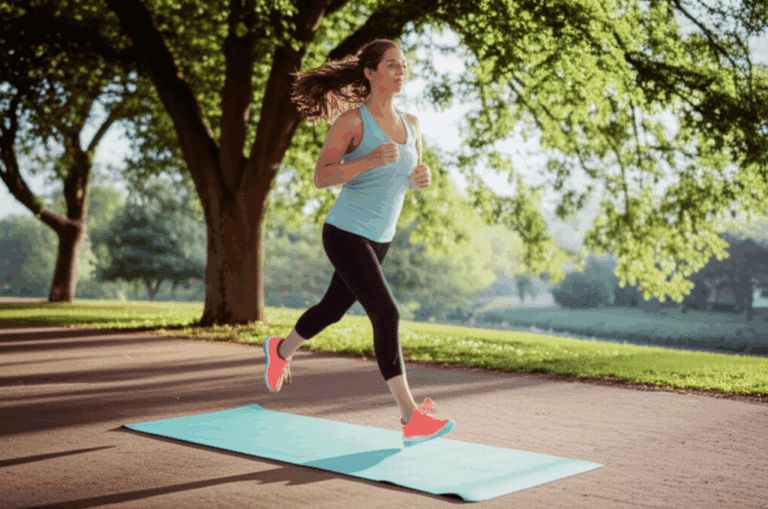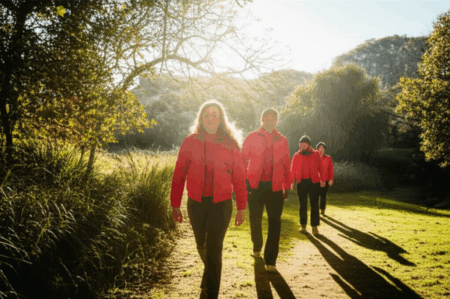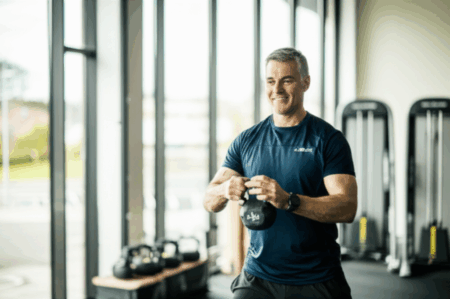Hitting 40 doesn’t mean hitting the brakes on fitness. It’s time to ditch the excuses, break free from inertia, and build an exercise routine that’s not only effective but also sustainable for the long haul. This isn’t about chasing your 20-year-old self; it’s about feeling strong, energetic, and confident in your own skin, right now.
Why Fitness in Your 40s is Non-Negotiable
As we gracefully age, our bodies undergo natural changes. Metabolism slows down, muscle mass decreases (sarcopenia), hormonal fluctuations occur, and joint stiffness becomes more noticeable. However, inactivity only accelerates these processes. Embracing fitness in your 40s is crucial for:
- Preserving Muscle Mass and Bone Density: Strength training becomes essential to combat muscle loss and maintain bone density, preventing conditions like osteoporosis.
- Boosting Metabolism and Managing Weight: Exercise helps rev up a sluggish metabolism, making it easier to manage weight and prevent unwanted gain.
- Improving Cardiovascular Health: Regular physical activity keeps your heart strong, lowers blood pressure, and reduces the risk of heart disease, the leading cause of death for women.
- Enhancing Mental Well-being: Exercise is a natural mood booster, reducing stress, anxiety, and depression while promoting better sleep.
- Preventing Age-Related Conditions: Staying active lowers your risk of developing chronic diseases like diabetes, heart disease, and certain cancers.
- Maintaining Mobility and Independence: Fitness ensures you can continue enjoying everyday activities with ease and maintain your independence as you age.
- Increasing Energy Levels: Exercise can combat fatigue and boost energy levels.
- Improving Balance: Practicing balance techniques can help prevent injuries.
- Increasing Sex Drive: Strength training can increase testosterone production and estrogen balance, which stands to boost sex drive and keep hormone levels consistent.
Overcoming the Hurdles: Common Challenges and Solutions
Getting started or maintaining a fitness routine in your 40s isn’t always easy. Here’s how to tackle common obstacles:
Challenge: Lack of Time
- Solution:
- Micro Workouts: Squeeze in 5-10 minute bursts of activity throughout the day.
- Combine Activities: Pair exercise with other tasks, like walking during phone calls or doing squats while watching TV.
- Prioritize and Schedule: Treat workouts like important appointments and schedule them in your calendar.
- Solution:
Challenge: Feeling Too Tired
- Solution:
- Morning Workouts: Exercise when your energy levels are highest.
- Active Breaks: Take short active breaks instead of relying on caffeine.
- Prioritize Sleep: Make sleep a priority to improve energy levels.
- Solution:
Challenge: Aches, Pains, and Injuries
- Solution:
- Low-Impact Options: Choose activities like swimming, cycling, or yoga that are gentle on your joints.
- Modify Exercises: Adjust exercises to suit your body’s needs and limitations.
- Listen to Your Body: Pay attention to pain signals and rest when needed.
- Warm-up Properly: Always warm up your muscles and joints before exercising.
- Solution:
Challenge: Lack of Motivation
- Solution:
- Set Realistic Goals: Start with small, achievable goals and gradually increase the challenge.
- Find Enjoyable Activities: Choose exercises you genuinely enjoy to stay motivated.
- Build a Supportive Community: Exercise with friends, join a fitness class, or find an online community for encouragement.
- Reward Yourself: Celebrate your achievements to stay motivated.
- Emotional Motivation: Consider what excellent health & fitness might mean for your life, or indeed what poor health & fitness might deprive you of.
- Solution:
The Ultimate Fitness Toolkit: Exercise Essentials for Your 40s
A well-rounded fitness routine in your 40s should incorporate these key components:
1. Strength Training: Your Fountain of Youth
- Why: Builds and maintains muscle mass, increases bone density, boosts metabolism, improves functional strength, and helps prevent age-related decline.
- How:
- Aim for 2-3 strength training sessions per week, targeting all major muscle groups (legs, back, chest, arms, shoulders, and core).
- Use free weights, resistance bands, or bodyweight exercises.
- Focus on compound movements like squats, deadlifts, lunges, bench presses, rows, and push-ups.
- Start with moderate weights and gradually increase intensity as your strength improves (progressive overload).
- Aim for 8-12 repetitions per set for muscle growth (hypertrophy).
- Prioritize proper form to prevent injuries.
- Rest days are essential for muscle growth and reducing the risk of injury.
- Exercises:
- Squats
- Deadlifts
- Lunges
- Bench press
- Rows
- Push-ups
- Bicep curls
- Tricep press
- Pull-ups or lat pulldowns
- Dumbbell rows
- Planks
- Example Routine
- Warm-up
- Squats: 3 sets of 8-12 reps
- Deadlifts: 3 sets of 8-12 reps
- Bench press: 3 sets of 8-12 reps
- Bicep curl: 3 sets of 8-12 reps
- Tricep press: 3 sets of 8-12 reps
- Pull-ups or lat pulldowns: 3 sets of 8-12 reps
- Dumbbell rows: 3 sets of 8-12 reps
- Planks: 3 sets of a 30-60 second hold
- Cool-down
2. Cardio: Fuel Your Heart and Soul
- Why: Maintains heart health, improves stamina, burns calories, reduces stress, and boosts endorphins.
- How:
- Aim for at least 150 minutes of moderate-intensity cardio per week.
- Choose activities you enjoy, such as brisk walking, jogging, cycling, swimming, dancing, or hiking.
- Incorporate interval training (HIIT) for shorter, more effective sessions.
- If you’re pressed for time, opt for high-intensity interval training (HIIT) for shorter, more effective sessions.
- Types:
- HIIT (High-Intensity Interval Training): Short bursts of intense exercise followed by brief recovery periods.
- SIT (Sprint Interval Training): Maximal intensity sprints with long recovery periods.
- VO2 Max Intervals: Longer intervals at a high intensity to improve aerobic capacity.
- Low-Impact Cardio: Swimming, cycling, brisk walking are excellent for maintaining heart health without straining joints.
- Example Routine
- Warm-up
- 20-30 minutes of brisk walking, cycling, swimming, or dancing.
- Cool-down
3. Flexibility and Mobility: Stay Supple and Injury-Free
- Why: Improves joint health, reduces stiffness, prevents injuries, enhances coordination, and promotes relaxation.
- How:
- Include dynamic stretches during your warm-up and static stretches during your cool-down.
- Add yoga or Pilates to your routine 1-2 times per week.
- Practice balance techniques, such as standing on one leg.
- Foam rolling helps improve joint range of motion, flexibility, athletic performance, muscle pain, and muscle recovery post-workout.
- Exercises:
- Dynamic Stretches: Arm circles, leg swings, torso twists.
- Static Stretches: Hamstring stretch, quad stretch, calf stretch, shoulder stretch.
- Yoga Poses: Child’s pose, downward-facing dog, warrior poses, cobra pose.
- Mobility Exercises: Cat-cow stretch, hip circles, ankle rotations.
- Hip mobility: Sit on the floor with your heels dug in and toes up.With knees and feet the same distance apart, keep the right knee still and ease the left knee inwards, aiming to touch the ground. Keep both buttocks in contact with the ground.Bring the left knee back up and switch to the right leg. Repeat 10 times.
- Quad stretch: On all-fours with a wall or sofa behind you, position your right knee slightly behind your left and raise your foot onto the wall. Bring your torso upright. Position your ear over your shoulder, your shoulder over the hip and tuck your tail under. You should feel a significant pull in your front thigh. If not, tuck your sacrum under a little more. If there is too much pull, shift the knee forward a bit (the one you’re stretching). Hold each side for 30 seconds.
- Mobility Moves:
- Shoulder Snow Angels
- Side Bends
- Hip Flow
- Hamstring End Range Isometric
4. Nutrition: Fuel Your Body from the Inside Out
- Why: Provides energy, supports muscle growth and repair, promotes bone health, and reduces the risk of chronic diseases.
- How:
- Prioritize a balanced diet rich in fruits, vegetables, whole grains, lean proteins, and healthy fats.
- Choose a variety of colorful fruits and vegetables for vitamins, minerals, and antioxidants.
- Include lean protein sources such as poultry, fish, beans, lentils, tofu, and Greek yogurt.
- Opt for whole grains like brown rice, quinoa, and oats for sustained energy and fiber.
- Incorporate healthy fats from sources like avocados, nuts, seeds, and olive oil.
- Limit processed foods, added sugars, and unhealthy fats.
- Stay hydrated by drinking plenty of water throughout the day.
- Ensure adequate calcium and vitamin D intake for bone health.
- Eat more foods with fiber (berries, whole grains, nuts) to fill you up and help you eat less.
- Foods to add to your diet
- Leafy greens: packed with calcium, magnesium, folate, and vitamin K, nutrients that support bone density, heart health, and cognitive function
- Fatty fish: Rich in omega-3 fatty acids, essential for heart and brain health
- Berries: loaded with antioxidants, especially flavonoids, which fight aging-related oxidative stress
- Nuts and seeds: excellent sources of protein, fibre, and healthy fats
- Greek yogurt:
- Whole grains: provide steady energy and are high in fibre, which supports digestive health and helps regulate cholesterol and blood sugar levels.
- Cruciferous vegetables:
- Legumes: rich in plant protein, iron, and fibre
- Avocados:
- Dark chocolate: offers powerful antioxidants like flavonoids, which improve blood flow and lower blood pressure
Sample Weekly Routine
Here’s a sample weekly routine that incorporates all the essential elements:
- Monday: Strength Training (Full Body)
- Tuesday: Cardio (Brisk Walking or Cycling) + Flexibility
- Wednesday: Rest or Active Recovery (Light Yoga or Stretching)
- Thursday: HIIT Workout
- Friday: Strength Training (Full Body)
- Saturday: Long Walk or Hike
- Sunday: Rest
Important Considerations
- Consult Your Doctor: Before starting any new exercise program, especially if you have underlying health conditions.
- Listen to Your Body: Pay attention to pain signals and adjust your routine as needed.
- Proper Form is Key: Focus on using correct form during exercises to prevent injuries.
- Warm-up and Cool-down: Always warm up before each workout and cool down afterward.
- Stay Consistent: Consistency is key to seeing results and making fitness a sustainable part of your lifestyle.
- Be Patient: It takes time to build strength, improve fitness, and see changes in your body.
- Enjoy the Process: Find activities you enjoy and celebrate your progress along the way.
- The fitness coach’s message is simple: Age is not a barrier to fitness and you can improve your strength, flexibility and overall health at any stage of life.
Your 40s: A Time for Empowerment
Your 40s are a time to embrace your strength, resilience, and wisdom. By prioritizing fitness, you’re not just investing in your physical health; you’re investing in your overall well-being and quality of life. Break free from inertia, build a sustainable exercise routine, and make your 40s your fittest and most fabulous decade yet!







